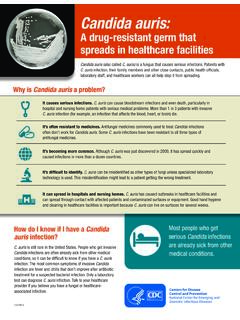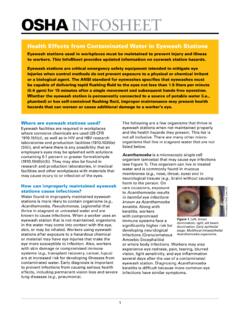Transcription of WHO | World Health Organization
1 WHO/HIV_ WHO/ W. WOORRLLDDHH. EA LTLT. EA H HO R. OGRAGNAIN. Z AT ION. I Z AT ION Original: English Distr.: General GUIDELINES. FOR THE MANAGEMENT OF. SEXUALLY TRANSMITTED INFECTIONS. Online: For orders, contact : World Health Organization Department of HIV/AIDS. 20 Avenue Appia , CH-1211 Geneva 27, Switzerland Phone: +41 22 791 2111. Direct fax: +41 22 791 4834. E-mail: WHO/HIV_ WHO/ Original: English Distr.: General GUIDELINES. FOR THE MANAGEMENT OF. SEXUALLY TRANSMITTED INFECTIONS. Online: For orders, contact : World Health Organization Department of HIV/AIDS. 20 Avenue Appia , CH-1211 Geneva 27, Switzerland Phone: +41 22 791 4654. Direct fax: +41 22 791 4834. E-mail: World Health Organization WHO/HIV_ WHO/ Original: English Distr.
2 : General GUIDELINES. FOR THE MANAGEMENT OF. SEXUALLY TRANSMITTED INFECTIONS. World Health Organization GUIDELINES FOR THE MANAGEMENT OF SEXUALLY TRANSMITTED INFECTIONS. Copyright World Health Organization 2001. This document is not a formal publication of the World Health Organisation (WHO), and all rights are reserved by the Organisation. The document may, however, be freely reviewed, abstracted, reproduced or translated, in part or in whole, but not for sale or for use in conjunction with commercial purposes. The views expressed in documents by named authors are solely the responsibility of those authors. Design by GUIDELINES FOR THE MANAGEMENT OF SEXUALLY TRANSMITTED INFECTIONS. CONTENTS. PREFACE vii 1. INTRODUCTION 1.
3 Iii Background 1. CONTENTS. Rationale for standardized treatment recommendations 1. Case management 2. Syndromic management 2. Risk factors for STI-related cervicitis 3. Selection of drugs 4. 2. TREATMENT OF STI-ASSOCIATED SYNDROMES 6. Urethral discharge 6. Persistent or recurrent urethral discharge 9. Genital ulcer 11. Genital ulcer and HIV infection 12. Inguinal bubo 15. Scrotal swelling 17. Vaginal discharge 20. Cervical infection 21. Vaginal infection 21. Lower abdominal pain 26. Neonatal conjunctivitis 30. 3. TREATMENT OF SPECIFIC INFECTIONS 32. Gonococcal infections 32. Uncomplicated anogenital infection 32. Disseminated infection 33. Gonococcal ophthalmia 33. GUIDELINES FOR THE MANAGEMENT OF SEXUALLY TRANSMITTED INFECTIONS.
4 Chlamydia trachomatis infections (other than lymphogranuloma venereum) 35. Uncomplicated urethral, endocervical or rectal infections 35. Neonatal chlamydial conjunctivitis 36. Infantile pneumonia 37. Lymphogranuloma venereum 37. Syphilis 38. Early syphilis 38. Late latent 38. iv Neurosyphilis 39. CONTENTS. Syphilis and HIV infection 40. Syphilis in pregnancy 40. Congenital syphilis 41. Chancroid 43. Granuloma inguinale (donovanosis) 44. Genital herpes infections 45. First clinical episode 45. Recurrent infections 45. Suppressive therapy 46. Herpes in pregnancy 47. Herpes and HIV co-infections 47. Venereal warts 47. Vaginal warts 49. Cervical warts 49. Meatal and urethral warts 50. Trichomonas vaginalis infections 50.
5 Bacterial vaginosis 52. Bacterial vaginosis in pregnancy 53. Candidiasis 54. Vulvovaginal candidiasis 54. Vulvovaginal candidiasis in pregnancy 54. Vulvovaginal candidiasis and HIV infection 55. Balanoposthitis 55. GUIDELINES FOR THE MANAGEMENT OF SEXUALLY TRANSMITTED INFECTIONS. Scabies 55. Phthiriasis (pediculosis pubis) 57. 4. KEY CONSIDERATIONS UNDERLYING TREATMENTS 58. The choice of antimicrobial regimens 58. Comments on individual drugs 61. Antimicrobial resistance in N. gonorrhoeae 62. Antimicrobial resistance in H. ducreyi 63. v 5. PRACTICAL CONSIDERATIONS IN CASE MANAGEMENT 65. CONTENTS. The Public Health package for STI prevention and care 65. Clinical considerations 66. Education for primary prevention 67.
6 Education and counselling during an STI consultation 68. Notification and management of sexual partners 69. Access to services 71. 6. CHILDREN, ADOLESCENTS AND SEXUALLY TRANSMITTED INFECTIONS 72. Evaluation for sexually transmitted infections 73. ANNEX. LIST OF PARTICIPANTS 78. Note 1999. The World Health Organization recommends that the term sexually transmitted disease (STD) be replaced by the term sexually transmitted infections (STI). The term sexually transmitted infections has been adopted as it better incorporates asymptomatic infections. In addition, the term has been adopted by a wide range of scientific societies and publications. Reproductive tract infections encompass three main groups of infection, particularly in women, and sometimes in men.
7 These groups are endogenous infections in the female genital tract ( candidiasis and bacterial vaginosis), iatrogenic infections that may be acquired through non-sterile medical, personal or cultural practices and classical STI. Currently, research is being conducted to better understand the determinants of endogenous infections. They are not primarily sexually transmitted; thus, clinical and public Health actions as recommended for STI may not apply to these infections. Given the current state of knowledge and understanding of these infections treatment of partners is not recommended as routine public Health practice. Reassurance and patient education are critical with regard to the nature of these endogenous infections.
8 GUIDELINES FOR THE MANAGEMENT OF SEXUALLY TRANSMITTED INFECTIONS. PREFACE. Sexually transmitted infections (STI) are among the most common causes of illness in the World and have far-reaching Health , social and economic consequences for many countries. vii The emergence and spread of HIV infection and AIDS have had a major impact on the PREFACE. management and control of STI. At the same time, resistance of several sexually transmitted pathogens to antimicrobial agents has increased, adding to therapeutic problems. In 1991,WHO published recommendations for the comprehensive management of patients with STI within the broader context of control, prevention and care programmes for STI and HIV convened an Advisory Group Meeting on Sexually Transmitted Diseases Treatment in May 1999 to review and update treatment recommendations in the light of recent developments (see annex).
9 This publication presents the revised recommendations, both for a syndromic approach to the management of patients with STI symptoms and for the treatment of specific STI, based on global epidemiological surveillance data. It also provides information on the notification and management of sexual partners and on STI in children and adolescents. GUIDELINES FOR THE MANAGEMENT OF SEXUALLY TRANSMITTED INFECTIONS. 1. INTRODUCTION. BACKGROUND. Sexually transmitted infections (STI) remain a public Health problem of major significance in most parts of the incidence of acute STI is believed to be high 1. in many countries and failure to diagnose and treat STI at an early stage may result in INTRODUCTION. serious complications and sequelae, including infertility, foetal wastage, ectopic pregnancy, anogenital cancer and premature death, as well as neonatal and infant individual and national expenditure for STI care can be substantial.
10 The appearance of the human immunodeficiency virus (HIV) and the acquired immunodeficiency syndrome (AIDS) has focused greater attention on the control of STI. There is a strong correlation between the spread of conventional STI and HIV. transmission and both ulcerative and non-ulcerative STI have been found to increase the risk of sexual transmission of HIV. The emergence and spread of HIV infection and AIDS complicated the management and control of some other STI. For example, the treatment of chancroid has become increasingly difficult in areas with a high prevalence of HIV infection, due to the HIV- related immunosuppression. Antimicrobial resistance of several sexually transmitted pathogens is increasing, rendering some regimens ineffective.












